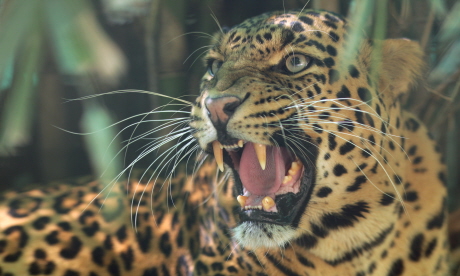
Naturalist Rom Whitaker on India's complex relationship with its wild leopards – and startling new research on how best to co-exist with them
Romulus (Rom) Whitaker is one of India's leading conservationist and wildlife film-makers and has dedicated much of his life to saving India’s endangered reptiles. A chance encounter with a leopard in his back garden led him on a quest to find out more about these big cats and their complex relationship with the people they share their habitat with.
The result is Leopards, 21st Century Cats, a thought-provoking film produced by Icon Films and set to be screened on BBC 2 on17 May 2013. Rom spoke with Peter Moore about the surprising encounters he had with leopards across India and the startling new research that suggests that the best way to deal with these predators is to learn to live with them.
Previously, your area of expertise has been reptiles. What made you do a programme about leopards?
It started literally in our backyard. We’ve got a farm that’s not far from the massive city of Chennai. Although it’s close to the city, we’re living next to a scrub jungle. OK, a scrub jungle has porcupines, civet cats and that sort of thing, but we weren’t aware that there were any leopards still there. We knew they were there in the past, at the turn of the century. There were even tigers there 100 years ago.
One day one of our dogs went missing and we thought it was stolen because it was a huge, beautiful German Shepherd. Then we got some tribal trackers in to help us look for it and they found the carcass, they found the body of the dog, completely eaten and, well, we knew we had a problem. We knew a leopard had moved in, 30 years since the last leopard had been seen.
How did the programme evolve from there?
Both my wife and I are in close contact with the other people doing research on wild animals in India, including the big cats. There was one girl in particular who features in the film, Vidya Athreya, and her findings about leopards were very, very interesting and quite revolutionary.
She believes that messing with them, translocating them and killing them off is actually creating more problems than it is solving. This sounded counter-intuitive so we wanted to go and see if what she was saying was true. So we visited her study site in Maharashtra.
We got to see almost diametrically opposed situations where the leopard situation is doing OK, where people are living with them, living right next to them and with hardly any problems at all. Then we got into other places where the situation is literally an attack a week. It’s really quite startling.
Leopards are often portrayed as solitary and secret creatures. Did you find that to be the case?
No. The first inkling was discovering that we had at least one (and now we know at least two), living in our vicinity. After making the film, I've discovered that there are people all over the country who are living next to them. Some people know they are living next to leopards but some are totally ignorant of the fact that they have big cats next door.
In Rajasthan, you met a guy who feeds them...
Devi Singh. He throws them a goat carcass every now and then. He says ‘If I don’t do this, they’re going to kill goats and people are going to poison the carcasses.' There is a history of people poisoning carcasses in the area, apparently. Whole families of leopards died after feasting on them. Giving them food occasionally was his way of “solving” the problem.
Yet up in the Himalayas you found the totally opposite situation where people are killing them.
That’s right. What is interesting is that it is the same area that Jim Corbett, the famous hunter, spent a lot of his time. In those days, it was primarily tigers causing the problem, but there was this one leopard that apparently chalked up 125 human victims.
The problem has escalated, or certainly changed since then. As well as the guys who are allowed legally to take out confirmed man-eaters, there’s a lot of poaching going on up there too. The leopards are under extreme pressure.
What was very fascinating to us was that we are in touch with people doing research in parts of the United States and Canada where people are allowed to hunt mountain lions. Invariably they choose the biggest males as a trophy. But by knocking them out they create a huge social upheaval among the mountain lion population. Younger males who are not used to humans come in and really don’t know how to act properly. They’re like rowdy teenagers, but more dangerous. It seems to be very similar to what’s happening in India.
What about tigers? Why has people's focus changed?
Tigers are few and far between now in comparison. There’s only a couple of thousand wild tigers left in India now. So the poachers have basically downgraded their search for any big cat and it’s now leopards. The bones and skins have become valuable.
Vidya Athreya suggests learning to live with the leopards is the answer. Do you agree?
Vidya is very convincing in her argument. And now she’s got the data to support it. Our experience when we visited her research site was quite remarkable. One of the leopards let us approach closely as it ate the carcass of a cat that it had killed.
There was no jungle there at all. The area comprises fields of sugar cane. Jungle doesn’t exist there any more. It’s quite a remarkable situation. The people seem to be much more relaxed about the whole thing than up in in the Himalaya. Everything that Vidya has found out was more or less proven to us.
I’m not a mammal person, but I was very impressed with the intelligence of these animals. You can either look at a big cat as a killing machine, or, like Vidya, take a more sympathetic, sensible, scholastic approach. It impressed me greatly that these leopards will keep out of the way if they are given the chance. If they’re forced into a situation, well, they'll react. But generally, they are very, very smart animals.
I was staggered to learn that there are leopards living in Mumbai.
That was totally amazing. Mumbai is massive and it’s noisy and yet there’s a park in the middle of it, the Sanjay Gandhi National Park, where leopards live.
The city surrounds the park on all sides, except for a creek at the top. The creek is probably the place where the leopards originally swam across and started colonising this park in the city limit.
They sound like the foxes in the UK – learning to live in urban environment, raiding garbage cans...
It’s exactly like that. They go through the garbage cans. And the number of stray dogs in India is phenomenal, so they provide a tasty meal too. So yes, they are like rather large foxes, only much more dangerous.
Are leopards under threat in India?
There are roughly between 12−15,000 leopards in India, but only 3-4% of the country is protected national parks and wildlife sanctuaries. At least 50% or more of them are living outside the protected areas. So the future of leopards is going to depend on how the forest departments and the wildlife authorities manage the animals, whether they trap or kill them or learn to live with them. But If we follow Vidya’s research, I think the leopard has a good chance of survival.
Finally, is the leopard still in your garden?
We got the last video clip of him walking by on my wife’s birthday – he was literally 50-feet away from our backdoor. We found three dead porcupines on our land, which were obviously eaten by a leopard. And last April we found tracks of a smaller leopard. We think it is probably a female. Leopard researchers have told us that the male leopard we got on the camera trap is not going to stick around unless there is a female around.
So you could end up with a family on your doorstep?
We’re waiting for the pitter-patter of tiny paws!
 Leopards, 21st Century Cats will be broadcast on Friday 17 May at 9pm by BBC2 as part of their Natural World series.
Leopards, 21st Century Cats will be broadcast on Friday 17 May at 9pm by BBC2 as part of their Natural World series.